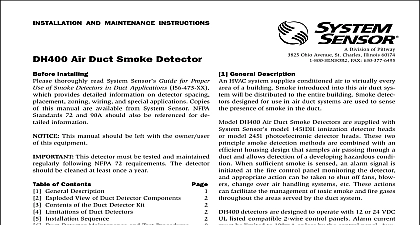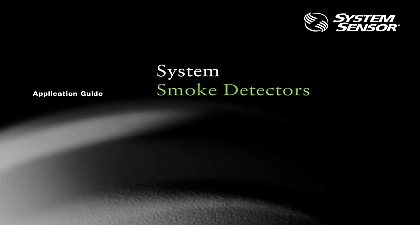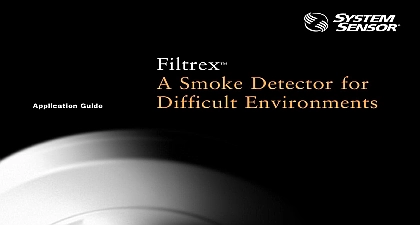System Sensor high temp heat detector

File Preview
Click below to download for free
Click below to download for free
File Data
| Name | system-sensor-high-temp-heat-detector-7410352689.pdf |
|---|---|
| Type | |
| Size | 1.45 MB |
| Downloads |
Text Preview
INSTALLATION AND MAINTENANCE INSTRUCTIONS Plug in Ionization Detector Temperature Range Humidity Range Alarm inches 6.1 cm inches 10.1 cm lb 277 g to 49 cid 176 C 32 cid 176 to 120 cid 176 F to 93 Relative Humidity Non condensing by momentary power interruption SENSOR Division of Pittway 3825 Ohio Avenue St Charles Illinois 60174 FAX 630 377 6495 1451 has been approved for marine use in dry loca by Underwriters Laboratory Inc The detector is to be in dry interior locations only of 30 ft on a smooth ceiling as per NFPA 72E conditions or response requirements vary other may apply Selection And Wiring Guide to the installation instructions for the plug in detector for wiring instructions System Sensor has available a of detector bases for this smoke detector including 2 applications with and without relays and or current lim resistors 4 wire and 120VAC applications Note the detector base is not available in Canada bases are provided with screw terminals for power remote annunciator connections and relay contact if applicable The electrical ratings for each combination are also included in the base in instructions installing thoroughly read the System Sensor manual I56 407 Manual for System Smoke Detectors which detailed information on detector spacing place zoning wiring and special applications Copies of manual are available at no charge from System Sensor installation in Canada refer to CAN ULC S524 Stan for the Installation of Fire Alarm Systems and CEC 1 Sec 32 This manual should be left with the owner user this equipment This sensor must be tested and maintained following NFPA 72 requirements This sensor be cleaned at least once a year Description 1451 dual chamber ionization detectors utilize state of unipolar sensing chambers These detectors are de to provide open area protection and to be used with UL listed control panels only The capability of these detectors into a variety of special bases makes more versatile than equivalent direct wired models LEDs on each detector light to provide a local 360 cid 176 vis alarm indication Remote LED annunciator capability available as an optional accessory These detectors also the latching alarm feature The alarm can be reset by a momentary power interruption For testing these have an internal magnetically activated reed Manuals Online All wiring must conform to applicable local codes and regulations Verify that all detector bases are installed that the circuits have been tested and that wiring is correct power from initiating device circuits before install detectors Install Detectors Place the detector into the detector base Turn the detector clockwise until the detector drops Continue turning detector clockwise to lock it in place Tamper proof Feature detector bases include a feature that when acti prevents removal of the detector without the use a tool See the installation instruction manual of the base for details in using this feature covers can be used to help limit dust entry to the de but they are not a substitute for removing the detec during building construction Remove any dust covers placing system in service testing notify the proper authorities that the smoke system is undergoing maintenance and will tem be out of service Disable the zone or system un maintenance to prevent unwanted alarms must be tested after installation and periodic The 1451 may be tested as follows testing the detector look for the presence of the LEDs If they do not flash either power has been to the detector check the wiring or it is defective re for repair Test Magnet System Sensor Model No M02 04 00 After all detectors have been installed apply power to control unit Place the magnet against the cover opposite the test socket See Figure 1 Test the detector as described under TESTING Reset the detector at the system control panel Notify the proper authorities that the system is in The LEDs on the detector should latch on within 30 Reset the detector at the system control panel 1 Botom and side views showing test magnet position MODULE Manuals Online Test Module System Sensor Model No MOD400R After cleaning snap the screen into the cover then place cover and screen assembly on the detector turning until it is locked in place MOD400 or MOD400R is used with a digital or ana voltmeter to check the detector sensitivity as de in the test module manual Reinstall the detector Aerosol Generator Gemini 501 Test the detector as described under TESTING the generator to represent 4 ft to 5 ft obscura as described in the Gemini 501 manual Using the shaped applicator apply aerosol until unit alarms Notify the proper authorities that the system is back on 2 the proper authorities that the system is back on that fail these tests should be cleaned as de under MAINTENANCE and retested If the detec still fail these tests they should be returned for repair is recommended that the detector be removed from its base to facilitate easier cleaning The detector is as follows Before removing the detector notify the proper au that the smoke detector system is under maintenance and will temporarily be out of Disable the zone or system undergoing to prevent unwanted alarms Remove the detector screen and cover assembly by de the three lock prongs on the top of the cover the cover counterclockwise and pulling the and cover assembly away from the detector See 2 Usage of a System Sensor CRT400 cover re tool is recommended Remove the screen from the cover Use a vacuum cleaner to remove dust from the screen cover and the sensing chamber cid 13 SCREEN cid 13 RS14 PRONG CHAMBER Manuals Online Limitations of Property Protection Smoke Detectors smoke detector is designed to activate and initiate emergency ac but will do so only when it is used in conjunction with an authorized alarm system This detector must be installed in accordance with standard 72 detectors will not work without power AC or DC powered detectors will not work if the power supply is cut off detectors will not sense fires which start where smoke does not the detectors Smoldering fires typically do not generate a lot of which is needed to drive the smoke up to the ceiling where the detector is usually located For this reason there may be large de in detecting a smoldering fire with either an ionization type detector a photoelectric type detector Either one of them may alarm only after has initiated which will generate the heat needed to drive the to the ceiling from fires in chimneys in walls on roofs or on the other side of a door s may not reach the smoke detector and alarm it A detector detect a fire developing on another level of a building quickly or at For these reasons detectors shall be located on every level and in bedroom within a building detectors have sensing limitations too Ionization detectors and detectors are required to pass fire tests of the flaming and type This is to ensure that both can detect a wide range of of fires Ionization detectors offer a broad range of fire sensing capa but they are somewhat better at detecting fast flaming fires than smoldering fires Photoelectric detectors sense smoldering fires better flaming fires which have little if any visible smoke Because fires de in different ways and are often unpredictable in their growth nei type of detector is always best and a given detector may not always early warning of a specific type of fire general detectors cannot be expected to provide warnings for fires re


